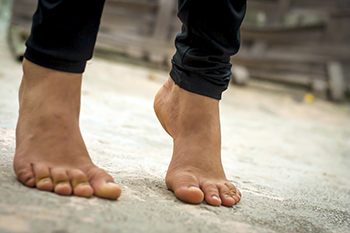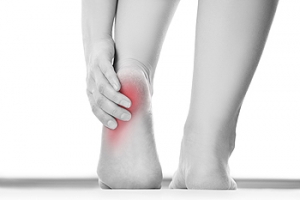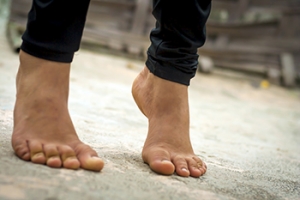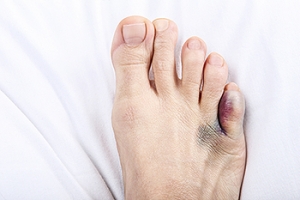
Is My Foot Broken, or Sprained?
 A fractured foot and a sprained foot can be difficult to tell apart as both conditions share several symptoms. A broken foot is typically more painful than a sprained foot, and the pain tends to last longer. Bruising, swelling, and tenderness are associated with both fractures and sprains, but are usually more severe in fractures. At the time of injury, you may hear a crack if there is a fracture, but a popping sound may occur if there is a sprain. Both fractures and sprains are likely to cause difficulty walking or bearing weight on the affected foot. If you have injured your foot, a podiatrist can use a combination of physical examination and imaging studies like X-rays, to determine the type of injury you have endured and which course of treatment is best for you.
A fractured foot and a sprained foot can be difficult to tell apart as both conditions share several symptoms. A broken foot is typically more painful than a sprained foot, and the pain tends to last longer. Bruising, swelling, and tenderness are associated with both fractures and sprains, but are usually more severe in fractures. At the time of injury, you may hear a crack if there is a fracture, but a popping sound may occur if there is a sprain. Both fractures and sprains are likely to cause difficulty walking or bearing weight on the affected foot. If you have injured your foot, a podiatrist can use a combination of physical examination and imaging studies like X-rays, to determine the type of injury you have endured and which course of treatment is best for you.
A broken foot requires immediate medical attention and treatment. If you need your feet checked, contact Dr. Lee R. Stein from Lake Shore Foot & Ankle, PC. Our doctor can provide the care you need to keep you pain-free and on your feet.
Broken Foot Causes, Symptoms, and Treatment
A broken foot is caused by one of the bones in the foot typically breaking when bended, crushed, or stretched beyond its natural capabilities. Usually the location of the fracture indicates how the break occurred, whether it was through an object, fall, or any other type of injury.
Common Symptoms of Broken Feet:
- Bruising
- Pain
- Redness
- Swelling
- Blue in color
- Numbness
- Cold
- Misshapen
- Cuts
- Deformities
Those that suspect they have a broken foot shoot seek urgent medical attention where a medical professional could diagnose the severity.
Treatment for broken bones varies depending on the cause, severity and location. Some will require the use of splints, casts or crutches while others could even involve surgery to repair the broken bones. Personal care includes the use of ice and keeping the foot stabilized and elevated.
If you have any questions please feel free to contact one of our offices located in Chicago, Highland Park, and Uptown, IL . We offer the newest diagnostic and treatment technologies for all your foot and ankle needs.
Causes, Symptoms, and Treatment for a Broken Foot
The human foot has 26 different bones, and the foot is divided into three parts: the hindfoot, the midfoot, and the forefoot. Each section of the foot is composed of a different amount of bones. For instance, the forefoot is made up of 19 bones. The midfoot is composed of five smaller bones called the navicular, cuboid, and three cuneiform bones. Lastly, the hindfoot is made up of only the talus and the calcaneus. The feet tend to be vulnerable to slipping and twisting; consequently, fractured bones within the foot are common. When a bone gets crushed, bent, twisted, or stretched it may become broken.
Many foot fractures occur through an accident or trauma. More specifically, common causes for broken feet are car accidents, falls, missteps, or overuse. If you have a broken ankle or foot, you may have one or more of the following symptoms: throbbing pain, swelling, bruising, tenderness, deformities, and difficulty walking.
There are some factors that may put you at a higher risk of developing a broken foot. People who participate in high-impact sports are more likely to develop foot fractures because of the stresses, direct blows, and twisting injuries involved in gameplay. Additionally, those who suddenly increase their activity level are more likely to suffer a stress fracture.
Unfortunately, there are different complications that may arise because of a foot fracture. For instance, arthritis may be caused by fractures that extend into the joints. Bone infections are also possible in open fractures due to the bone being exposed to bacteria. However, there are ways you can help prevent yourself from breaking your foot. One way to avoid fractures is to wear proper footwear. If you plan on going on a run, you should wear running shoes. You should also replace your shoes if you notice that they are becoming worn out. For runners, it is best to replace shoes every 300 to 400 miles.
Treatment for foot fractures usually consists of rest, ice, elevation, and compression (RICE). If you plan on wrapping your foot, try not to wrap it too tightly because doing so may cut off blood supply in the foot. You should also avoid walking on the fractured foot.
If you suspect you have a broken foot, you should see your podiatrist right away. It is important that you have someone bring you to your doctor, since driving with a broken foot can be dangerous. You should especially seek urgent care if you are experiencing numbness, pain, or deformities in your foot.
A Disease That Can Affect Children's Foot Health
 One of the medical conditions that children can suffer from is known as hand-foot-mouth disease. This is a viral infection, and often appears in the summer and fall. The symptoms many children experience include blisters that can form on the mouth, soles of the feet, and the palm of the hands. Additionally, some children may begin to cough, and can develop a fever. It is considered to be contagious, and can spread from sneezing, coughing, or talking. It is recommended that the child refrains from school activities until all signs of this condition are gone. If your child has a foot rash, it is strongly suggested that you seek the counsel of a podiatrist who can determine the cause.
One of the medical conditions that children can suffer from is known as hand-foot-mouth disease. This is a viral infection, and often appears in the summer and fall. The symptoms many children experience include blisters that can form on the mouth, soles of the feet, and the palm of the hands. Additionally, some children may begin to cough, and can develop a fever. It is considered to be contagious, and can spread from sneezing, coughing, or talking. It is recommended that the child refrains from school activities until all signs of this condition are gone. If your child has a foot rash, it is strongly suggested that you seek the counsel of a podiatrist who can determine the cause.
The health of a child’s feet is vital to their overall well-being. If you have any questions regarding foot health, contact Dr. Lee R. Stein of Lake Shore Foot & Ankle, PC. Our doctor can provide the care you need to keep you pain-free and on your feet.
Tips for Keeping Children's Feet Healthy
- Make sure their shoes fit properly
- Look for any signs of in-toeing or out-toeing
- Check to see if they have Clubfoot (condition that affects your child’s foot and ankle, twisting the heel and toes inward) which is one of the most common nonmajor birth defects.
- Lightly cover your baby’s feet (Tight covers may keep your baby from moving their feet freely, and could prevent normal development)
- Allow your toddler to go shoeless (Shoes can be restricting for a young child’s foot)
- Cut toenails straight across to avoid ingrown toenails
- Keep your child’s foot clean and dry
- Cover cuts and scrapes. Wash any scratches with soap and water and cover them with a bandage until they’ve healed.
If you have any questions, please feel free to contact one of our offices located in Chicago, Highland Park, and Uptown, IL . We offer the newest diagnostic and treatment technologies for all your foot care needs.
How to Care for Your Child's Feet
It is never normal for a child to experience pain in his or her feet. Foot pain that lasts more than a few days and limits a child’s ability to walk should be examined by a podiatrist. Many adult foot ailments originate in childhood and may be present at birth. Common foot issues that are experienced by children are pediatric flat foot, Sever’s disease, ingrown toenails, and plantar warts.
A child’s foot grows rapidly during the first year, allowing it to reach almost half of their adult foot size. Consequently, foot specialists consider the first year to be the most crucial point in the foot development process. There are ways you can help ensure that your child’s foot develops properly. One way is to carefully look at your baby’s feet. If you notice any deformities, you should immediately seek professional care. You should also loosely cover your child’s foot, since tight coverings may prevent movement and inhibit normal development. Another tip is to change the baby’s positioning throughout the day. If your baby lies down in one spot for too long, it may put an excess amount of strain on the feet and legs.
It is best that you try not to force a child to start walking. Children will begin to walk when they are both physically and emotionally capable to do so. You should also avoid comparing your child’s walking progress with other children because the age range for independent walking may range. When your child’s feet begin to develop, you may need to change both their shoe and sock size every few months to allow room for their feet to grow.
Kids are sometimes prone to splinters, cuts, and severe injuries because they tend to walk around barefoot. This also makes them more susceptible to developing plantar warts which is a condition caused by a virus that invades the sole of the foot through breaks in the skin. These ailments can be avoided by making sure your child wears shoes in unsanitary environments. You should also wash any minor cuts or scrapes on your child’s feet. It is a myth that exposure to fresh air will heal injuries; fresh air will only expose your child’s cuts to germs.
As a parent, you should ensure that your child’s feet are developing properly and are being properly maintained. Consequently, it is important that you perform routine inspections on his or her feet to detect any injuries or deformities in their early stages. Early detection and treatment will help to ensure that your child does not develop any serious foot conditions.
Why Live with Pain and Numbness in Your Feet?
The Three Most Common Causes of Heel Pain
 Heel pain is one of the most frequent complaints addressed by podiatrists. While there can be many causes for heel pain, the three most common causes are plantar fasciitis, Achilles tendonitis, and blisters. Plantar fasciitis is an inflammation of the ligament that runs along the bottom of the foot. It is caused by repetitive overuse from running, standing for prolonged periods of time, or wearing ill-fitting and uncomfortable shoes. The heel pain from this condition is usually at its worst upon taking your first steps in the morning. Achilles tendonitis is an inflammation of the tendon that connects your calf muscles to your heel bone. Like plantar fasciitis, this condition is also caused by overexertion of the tendon during physical activities. Blisters are fluid-filled bubbles of skin that form over a concentrated area of the foot due to friction. They can be prevented by wearing shoes and socks that fit properly and do not rub excessively against the foot. If you are suffering from heel pain, please seek the care of a podiatrist.
Heel pain is one of the most frequent complaints addressed by podiatrists. While there can be many causes for heel pain, the three most common causes are plantar fasciitis, Achilles tendonitis, and blisters. Plantar fasciitis is an inflammation of the ligament that runs along the bottom of the foot. It is caused by repetitive overuse from running, standing for prolonged periods of time, or wearing ill-fitting and uncomfortable shoes. The heel pain from this condition is usually at its worst upon taking your first steps in the morning. Achilles tendonitis is an inflammation of the tendon that connects your calf muscles to your heel bone. Like plantar fasciitis, this condition is also caused by overexertion of the tendon during physical activities. Blisters are fluid-filled bubbles of skin that form over a concentrated area of the foot due to friction. They can be prevented by wearing shoes and socks that fit properly and do not rub excessively against the foot. If you are suffering from heel pain, please seek the care of a podiatrist.
Many people suffer from bouts of heel pain. For more information, contact Dr. Lee R. Stein of Lake Shore Foot & Ankle, PC. Our doctor can provide the care you need to keep you pain-free and on your feet.
Causes of Heel Pain
Heel pain is often associated with plantar fasciitis. The plantar fascia is a band of tissues that extends along the bottom of the foot. A rip or tear in this ligament can cause inflammation of the tissue.
Achilles tendonitis is another cause of heel pain. Inflammation of the Achilles tendon will cause pain from fractures and muscle tearing. Lack of flexibility is also another symptom.
Heel spurs are another cause of pain. When the tissues of the plantar fascia undergo a great deal of stress, it can lead to ligament separation from the heel bone, causing heel spurs.
Why Might Heel Pain Occur?
- Wearing ill-fitting shoes
- Wearing non-supportive shoes
- Weight change
- Excessive running
Treatments
Heel pain should be treated as soon as possible for immediate results. Keeping your feet in a stress-free environment will help. If you suffer from Achilles tendonitis or plantar fasciitis, applying ice will reduce the swelling. Stretching before an exercise like running will help the muscles. Using all these tips will help make heel pain a condition of the past.
If you have any questions please contact one of our offices located in Chicago, Highland Park, and Uptown, IL . We offer the newest diagnostic and treatment technologies for all your foot and ankle needs.
Heel Pain
Heel pain can be difficult to deal with, especially if you do not know what the underlying cause is. If you ignore your heel pain, the pain can magnify and potentially develop into a chronic condition. Depending on the location of your heel pain, you have developed a specific condition.
One condition is plantar fasciitis. Plantar fasciitis is caused by the inflammation of the plantar fascia, or the band of tissue that connects the heel bone to the base of the toes. The pain from this condition is initially mild but can intensify as more steps are taken when you wake up in the morning. To treat this condition, medication will likely be necessary. Plantar fasciitis is often associated with heel spurs; both require rest and special stretching exercises.
There are various options your podiatrist may suggest for heel pain. Treatment options for heel pain typically include non-steroidal anti-inflammatory drugs (NSAIDS), which may reduce swelling and pain. Other options are physical therapy, athletic taping, and orthotics. In severe cases of heel pain, surgery may be required.
Preventing heel pain is possible. If you are looking to prevent heel pain from developing in the future, be sure to wear shoes that fit you properly and do not have worn down heels or soles. Be sure to warm up properly before participating in strenuous activities or sports that place a lot of a stress on the heels. If you are experiencing any form of heel pain, speak with your podiatrist to determine the underlying cause and receive the treatment you need.
Complications of Overly Sweaty Feet
 We all deal with foot sweat from time to time, but if you find that your feet are wet, clammy, or leaving soggy footprints on the floor, you may have plantar hyperhidrosis. Hyperhidrosis is a medical condition that causes excessive sweating. It can affect various parts of the body, but is particularly common in feet. Other than being annoying and possibly embarrassing, untreated plantar hyperhidrosis can have health consequences. Excessive sweating can make the feet perpetually moist, increasing the risk of fungal (athlete’s foot, toenail fungus), bacterial (folliculitis), and viral (warts caused by HPV) infections and skin breakdown. A heat rash, which causes itching, redness, and stinging, may also develop. If you are suffering from plantar hyperhidrosis, a podiatrist can help find the most effective treatment for you.
We all deal with foot sweat from time to time, but if you find that your feet are wet, clammy, or leaving soggy footprints on the floor, you may have plantar hyperhidrosis. Hyperhidrosis is a medical condition that causes excessive sweating. It can affect various parts of the body, but is particularly common in feet. Other than being annoying and possibly embarrassing, untreated plantar hyperhidrosis can have health consequences. Excessive sweating can make the feet perpetually moist, increasing the risk of fungal (athlete’s foot, toenail fungus), bacterial (folliculitis), and viral (warts caused by HPV) infections and skin breakdown. A heat rash, which causes itching, redness, and stinging, may also develop. If you are suffering from plantar hyperhidrosis, a podiatrist can help find the most effective treatment for you.
If you are suffering from hyperhidrosis contact Dr. Lee R. Stein of Lake Shore Foot & Ankle, PC. Our doctor can provide the care you need to attend to all of your foot and ankle needs.
Hyperhidrosis of the Feet
Hyperhidrosis is a rare disorder that can cause people to have excessive sweating of their feet. This can usually occur all on its own without rigorous activity involved. People who suffer from hyperhidrosis may also experience sweaty palms.
Although it is said that sweating is a healthy process meant to cool down the body temperature and to maintain a proper internal temperature, hyperhidrosis may prove to be a huge hindrance on a person’s everyday life.
Plantar hyperhidrosis is considered to be the main form of hyperhidrosis. Secondary hyperhidrosis can refer to sweating that occurs in areas other than the feet or hands and armpits. Often this may be a sign of it being related to another medical condition such as menopause, hyperthyroidism and even Parkinson’s disease.
In order to alleviate this condition, it is important to see your doctor so that they may prescribe the necessary medications so that you can begin to live a normal life again. If this is left untreated, it is said that it will persist throughout an individual’s life.
A last resort approach would be surgery, but it is best to speak with your doctor to find out what may be the best treatment for you.
If you have any questions please feel free to contact one of our offices located in Chicago, Highland Park, and Uptown, IL . We offer the newest diagnostic and treatment technologies for all your foot and ankle needs.
Hyperhidrosis of the Feet
Hyperhidrosis of the feet, also termed plantar hyperhidrosis, is characterized by excessive sweating of the feet that can be onset by any cause, such as exercise, fever, or anxiety. Most people suffering from hyperhidrosis of the feet also experience hyperhidrosis of the hands, or palmar hyperhidrosis. Approximately 1-2% of Americans suffer from this disorder.
Sweating is a healthy process utilized by the body in order to cool itself and maintain a proper internal temperature, which is controlled by the sympathetic nervous system. In individuals with hyperhidrosis, the sympathetic nervous system works in "overdrive", producing far more sweat than is actually needed.
Plantar hyperhidrosis is considered primary hyperhidrosis. Secondary hyperhidrosis refers to excessive sweating that occurs in an area other than the feet, hands, or armpits, and this indicates that is related to another medical condition, such as menopause, hyperthyroidism, or Parkinson's disease.
Symptoms of hyperhidrosis of the feet can include foot odor, athlete's foot, infections, and blisters. Because of the continual moisture, shoes and socks can rot which creates an additional foul odor and can ruin the material, requiring shoes and socks to be replaced frequently. In addition to the physical symptoms, emotional health is often affected as this disorder can be very embarrassing.
If left untreated, hyperhidrosis will usually persist throughout an individual's life. However, there are several treatment options available. A common first approach to treating hyperhidrosis of the feet is a topical ointment. Aluminum chloride, an ingredient found in antiperspirants, can be effective at treating hyperhidrosis if used in high concentration and applied to the foot daily. Some individuals can experience relief this way, while others encounter extreme irritation and are unable to use the product. Another procedure is the use of Botulinum Toxin A, commonly referred to as Botox. This is injected directly into the foot, and is effective at minimizing the sweat glands in the injected area. These injections must be repeated every 4 to 9 months.
If these treatments are ineffective, oral prescription medications may be taken in an effort to alleviate the symptoms. Again, some will experience relief while others do not. Going barefoot reportedly provides relief for most sufferers.
A final approach to combating hyperhidrosis of the feet is through surgery. Surgery has been less successful on patients with plantar hyperhidrosis than on those with palmar hyperhidrosis. It is only recommended when sweating is severe and other treatments have failed to work. This kind of surgery usually involves going into the central nervous system, and cutting nerves to stop the transmission of signals telling the foot to sweat.
Types of Foot Bones Commonly Affected by Stress Fractures
Your feet are made up of 26 bones. While any of these bones can be fractured, there are three foot bones in which stress fractures are particularly common. The metatarsal bones account for between 17% and 35% of all foot stress fractures. These bones are located near the front part of your foot and connect the toes to the midfoot. Metatarsal fractures are especially common among runners and dancers. The calcaneus or heel bone is the site of 21% to 28% of stress fractures. The navicular bone, which is located on the top of the foot, is also a common site of stress fractures. Stress fractures can worsen without treatment, causing pain, tenderness, swelling, bruising, and weakness that interferes with daily activities. If you suspect that you have broken a bone in your foot, please seek the care of a podiatrist.
Activities where too much pressure is put on the feet can cause stress fractures. To learn more, contact Dr. Lee R. Stein from Lake Shore Foot & Ankle, PC. Our doctor can provide the care you need to keep your pain free and on your feet.
Dealing with Stress Fractures of the Foot and Ankle
Stress fractures occur in the foot and ankle when muscles in these areas weaken from too much or too little use. The feet and ankles then lose support when walking or running from the impact of the ground. Since there is no protection, the bones receive the full impact of each step. Stress on the feet can cause cracks to form in the bones, thus creating stress fractures.
What Are Stress Fractures?
Stress fractures occur frequently in individuals whose daily activities cause great impact on the feet and ankles. Stress factors are most common among:
- Runners
- People affected with Osteoporosis
- Tennis or basketball players
- Gymnasts
- High impact workouts
Symptoms
Pain from the fractures occur in the area of the fractures and can be constant or intermittent. It will often cause sharp or dull pain with swelling and tenderness. Engaging in any kind of activity which involves high impact will aggravate pain.
If you have any questions please feel free to contact one of our offices located in Chicago, Highland Park, and Uptown, IL . We offer the newest diagnostic and treatment technologies for all your foot and ankle needs.















